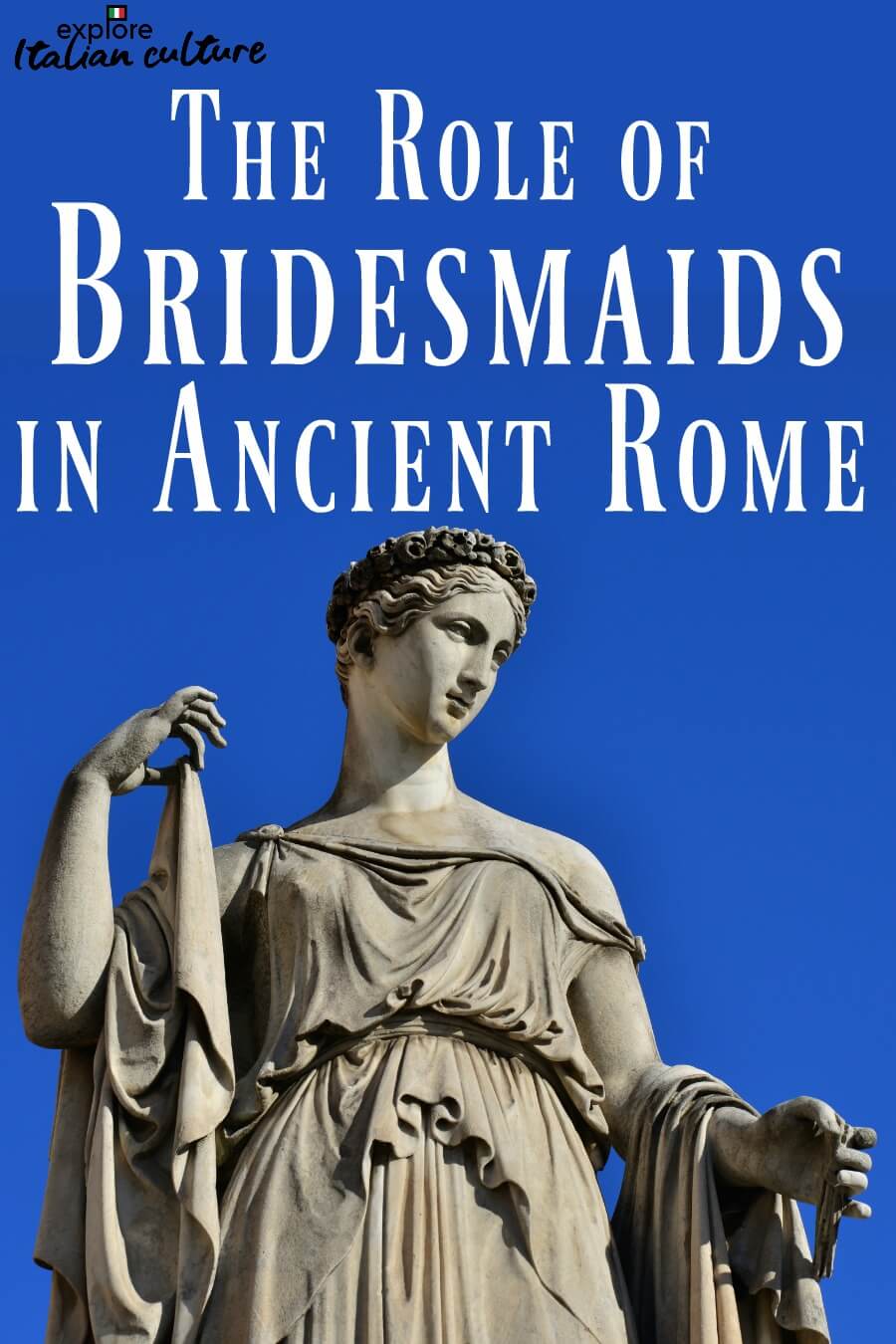Bridesmaid duties in ancient Roman and modern Italian weddings.
How have ancient Roman women influenced modern Italian weddings? Are bridesmaid duties the same now as in ancient times?
Is it ever right to have bridesmaids dressed in white?! How many bridesmaids is too many? And should the maids' hair reflect the bride's?
Answers to all these questions and more can be found in the traditions of ancient Rome. Many customs still seen in modern weddings in Italy come from the superstitions and culture of ancient Roman weddings. Bridesmaid duties are no exception.
This article looks at how women in the Roman Empire have contributed bridesmaid hair ideas, dresses and accessories to modern weddings, and what you can do to replicate them for your own Italian-themed, or Italy-based, celebrations.
Ancient Roman fashion and the bridesmaid.
The ancient Romans believed that on any wedding day evil spirits would gather where the marriage was being celebrated in order to ruin the happy atmosphere. One of the main bridesmaid duties was to get rid of, or at least confuse, the spirits.
So bridesmaid dress patterns would be very similar to the bride's: a floor length tunic with no trim, tied at the bodice and waist with a single length of cord.
Unable to tell which woman was the bride, belief was that the spirits would leave all the women in the wedding party alone.
That tradition of bride and bridesmaid dress patterns being the same has continued in some areas of Italy, so there isn't a problem if you want your bridesmaids to wear similar styles.
Where the problems do arise today, however, is in the colour.
White bridesmaid dresses: outshining the bride?
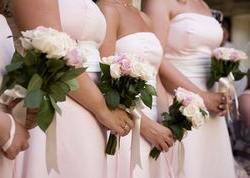 |
|
Light pink wedding and bridesmaid dresses
are popular in Italy. |
White bridesmaid dresses were not only acceptable in Italy, but required, from ancient Roman weddings right up until the mid-20th Century.
But these days it's not appropriate. No-one should try to outshine the bride by wearing white at her wedding!
However, there's a relatively simple solution if you want to follow old Italian traditions.
Women in ancient Rome also often wore pale rose or pale lilac, and those same colours are perfectly accessible today.
Bridesmaid hairstyles.
Ancient Roman women originally dressed their hair very simply, allowing it to fall down their back in ringlet-type curls with a single narrow band worn encircling the head.
However, as the Empire's importance grew, women spent more and more time designing increasingly elaborate hairstyles and invested a great deal of time and money to perfect their look.
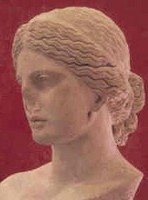
We know from statues and wall paintings that ancient Roman fashion for brides was somewhere between these two style. The hair was parted into six sections, each one curled and piled on top of the head, leaving strands at the side and back.
The bridesmaid up-do hairstyle was almost the same. The hair was arranged in layers of curls on top with loose ringlets at the sides and back. It was decorated with a head dress of fresh flowers, similar to but smaller than the bride's.
Bridesmaid hairstyles for weddings in Italy currently are very similar. The hair is generally curled and taken off the face, with tendrils falling at the sides and back to soften the effect.
Timeless and elegant - Italian style.
Bridesmaid duties: how many bridesmaids should there be?
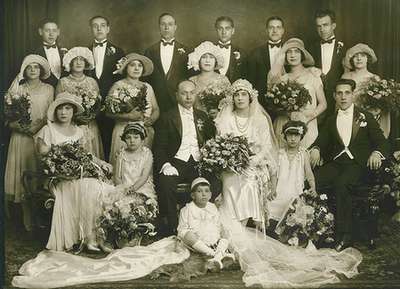 |
|
Italian wedding, 1920s, with the statutory ten bridesmaids.
Notice the similarity of the dresses and hats. |
As well as warding off evil spirits, one of the main bridesmaid duties in ancient Rome was to be an official witness at the wedding. Because Roman law required ten witnesses to any marriage, it was not unusual to find ten or more bridesmaids at a wedding.
These days only two witnesses are required at Italian weddings: one for the groom and the second for the bride.
So how many bridesmaids should there be at a modern wedding in Italy, or an Italian themed wedding anywhere?
Custom would suggest at least five, plus five groomsmen, but the major factor in the "how many bridesmaids" question these days is money. It may be a stunning spectacle to have ten bridesmaids, but it's not cheap. Most Italian brides these days settle for one or two. Some rely on parents to act as their witnesses. It's a personal decision and it doesn't stick to the traditions of ancient Rome.
Weddings in America, which often have a large number of women attendants all dressed similarly, are actually much closer to ancient Italian culture and traditions.
Bridesmaid duties: the role of the 'matron of honour'.
The role of matron of honour seems to have been more active in ancient Roman weddings than even the mother of the bride. She had very clear "chief bridesmaid" duties.
As a role model she had to be married no more than once, with a living husband, and it was critical that she be known for her fidelity and obedience. In that way she was shown to be in a moral position to guide and give advice to the bride.
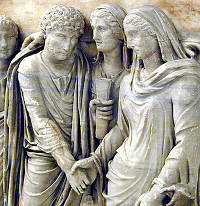
We know from statues and writings that during the ceremony she played an active role. It was her duty to join the right hands of the bride and bridegroom for the first time - a part often played in today's ceremony by the father of the bride.
Italian weddings today usually do have a 'matron of honour' or 'damigella d'onore' but she tends to be the bride's best friend rather than a source of moral guidance.
Her special bridesmaid duties, though, are essentially the same: to look after and support the bride through the stresses of pre-wedding planning and wedding day nerves.
Translating ancient bridesmaid duties into modern day traditions.
What should you be planning if you want your bridesmaid duties to reflect ancient Roman culture?
Here are our suggestions :
If you want to follow ancient Roman fashion exactly, you should have ten witnesses, at least five of whom will be bridesmaids.
Ask your hairdresser to practice the bridesmaids' up-do hairstyles so that they look similar to the bride's. There should be tiny loose tendrils around the face and some stray strands at the back of the neck.
Make sure that at least your young maids have flower wreaths as their head-dress. Older bridesmaids could have tiny sprays of flowers dotted in the back of their upswept hair.
Make sure your bridesmaids have the same dresses in order to confuse anyone with evil intent! Ideally, they should be similar in style to the bride's dress.
White bridesmaid dresses aren't appropriate these days, but light pink and light lilac was also a favourite colour in ancient Rome, so stick with those.
The bridesmaids should carry a small bouquet which is similar in style to the bride and in a light pastel colour to match their dress.
